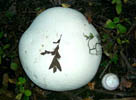Terms discussed: Agarikon, Bolet, Porcinus, Suillus (pl. Suilli)
This term is used is a special sense in botany: to refer to the pre-binomial writers and taxa, and to refer to pre-scientific writers and taxa.
Topics:
Pre-binomial
Truly ancient
Pre-binomial
When used by botanists, the word ancient usually refers to a writer who was active before the binomial system took over, or to a name that pre-dates the binomial system. Thus, any writer or name published before Fries or Persoon is " ancient". Ancient names have to be validated before they can be used, and usually were validated by either Fries or Persoon. This type of ancient writer is usually European, and usually lived in the 16th through early 18th century.
Back to top
Truly ancient
A number of the scientific names that we use for mushrooms actually do date from ancient times, and are known through the writings of the Greeks and Romans.
Agarikon is the name of an ancient Scythian people; the Agarikon itself was one of those big tinder conks, and it was so important to them that they took it as a totem and named themselves after the fungus.
Amanita is a Greek word for some type of field mushroom, a Lepiota or Agaricus.
Suillus and Porcinus (plural porcini) are words derived from Roman words for pigs, and are intended to convey the inferiority of other types of mushrooms when compared to Amanita caesarea, which was at that time called the Bolet. The root, -bol, means something that you can throw, and survives in our english word Ball, and the mycological names Sphaerobolus and Pilobolus; it refers to A. caesarea's habit of coming up from the ground completely wrapped in its universal veil, at which point it resembles a ball.
Back to top
How did the modern sense of these words become so changed? Well, according to John Ramsbottom's (1953) Mushrooms and Toadstools, Dillenius started the erosion in his Catalogus Plantarum circa Gissam sponte nascentium, where he used Boletus, Peziza (which originally referred to the Giant Puffball), and Amanita in a way that was totally at odds with their original meanings. Then Linnaeus wrote his Species Plantarum, used Dillenius' names, and in addition used Agaricus in its modern sense, and also Hydnum (originally a truffle) and Elvella (originally a vegetable), thus casting these misapplied terms in stone for future generations of biologists. No one knows why he did this, and Ramsbottom reports that there were protests at the time, but Linnaeus won, so here we are. William Alphonso Murrill tried to use the word Agaricus in its original sense in 1905, but no one paid any attention to him.
Back to top
I should also mention that the scientific term for fungi in general is from the Greek word for mushroom, mykes. Ramsbottom opines that this is from the same root as the scientific term myxo-, meaning slimy, because mushrooms are often slimy. He also mentions the Greek myth that the capitol city of Agamemnon (et alia) was named Mycenae after a mushroom: Perseus, the mythical founder of the city, found a mushroom on the spot and enjoyed it, and decided to name his city after the mushroom.
Back to top











